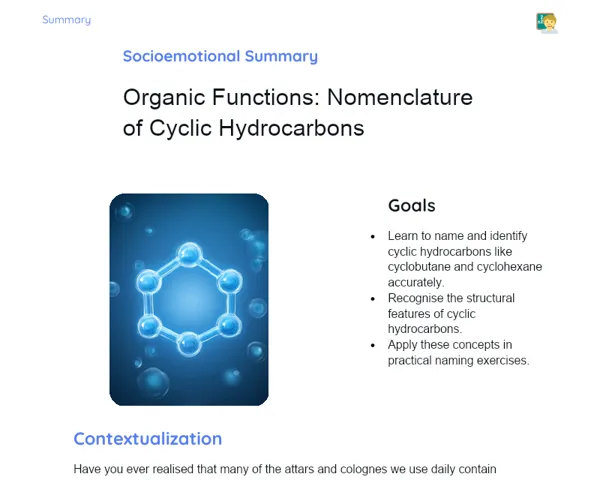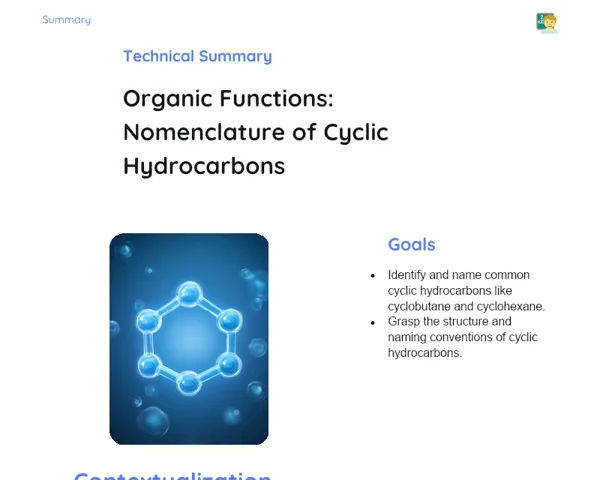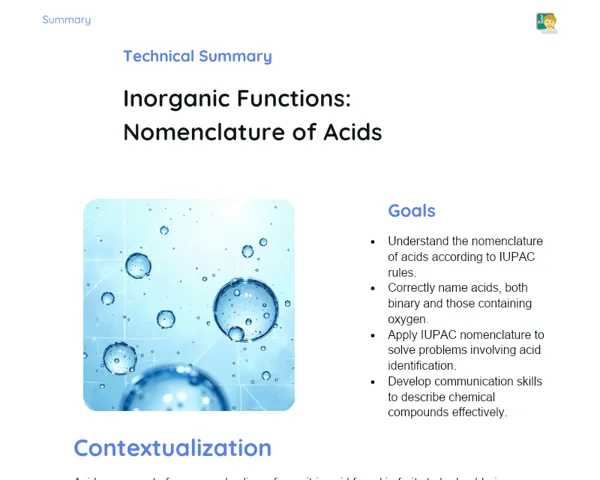Summary Tradisional | Stoichiometry: Limiting and Excess
Contextualization
Stoichiometry forms an integral part of Chemistry, dealing with the quantitative relations between reactants and products during chemical reactions. It helps us predict how much product can be formed from given reactant quantities. In many cases, the reactants may not be present in perfect stoichiometric ratios, which means one reactant may get consumed before the others, thereby controlling the amount of product produced. This reactant is termed the limiting reagent, whereas those left out after the reaction are known as excess reagents.
Grasping how to determine the limiting reagent and calculate the excess is vital not only for academic studies but also for enhancing the efficiency of chemical processes in various sectors such as pharmaceuticals, food processing and even in small-scale local industries. For example, in drug manufacturing, knowing which reactant is likely to run out first ensures the reaction is cost-effective and minimizes wastage. This concept also finds relevance in biological processes within our bodies, where the correct availability of reactants is essential for proper functioning. Hence, understanding these principles can lead to improved industrial practices, sustainability and prudent resource management.
To Remember!
Review of Basic Stoichiometry Concepts
Stoichiometry is the branch of Chemistry that investigates the quantitative relationships between reactants and products in a chemical reaction. It is based on the principle that the total mass of the reactants must equal the total mass of the products, in accordance with the Law of Conservation of Mass. To perform stoichiometric calculations, it is essential that the chemical equations are balanced, meaning that each element has an equal number of atoms on both sides of the equation.
Molar relationships play a crucial role in stoichiometry, as they allow the conversion from moles of one substance to moles of another according to the ratios given in the balanced equation. For instance, in the reaction between hydrogen and oxygen to form water (2H₂ + O₂ → 2H₂O), the molar ratio of hydrogen to water is 2:2, and that of oxygen to water is 1:2.
In addition to ensuring the equations are balanced, it is important to understand how to determine the amount of product formed from a known quantity of reactants. This involves using the molar proportions from the balanced equation, which then helps in predicting the extent of the reaction.
-
Definition of stoichiometry and its importance.
-
Law of Conservation of Mass.
-
Balancing chemical equations.
-
Molar relationships and conversion between moles of reactants and products.
Limiting Reagent
The limiting reagent in a chemical reaction is the substance that gets used up first, thereby stopping the reaction from progressing further. Recognising the limiting reagent is key to determining the maximum product yield of a reaction. To identify the limiting reagent, one compares the available moles of each reactant with the stoichiometric ratios provided by the balanced equation.
For example, consider the reaction N₂ + 3H₂ → 2NH₃. If you start with 5 moles of N₂ and 10 moles of H₂, a calculation will show that one reactant produces less ammonia than the other – in this case, hydrogen (H₂) limits the reaction. Consequently, the production of ammonia (NH₃) depends solely on the amount of hydrogen available.
Determining the limiting reagent is not just an academic exercise but holds significant practical value. For instance, in the pharmaceutical sector, knowing the limiting reagent helps in resource management and in streamlining the production process for better efficiency.
-
Definition of limiting reagent.
-
Importance of the limiting reagent in determining product yield.
-
Example of calculating the limiting reagent.
-
Practical application in industry.
Excess Reagents
Excess reagents are those that do not completely react in a chemical process and remain even after the reaction has concluded. It is important to identify these reagents to optimise the overall use of materials and to prevent wastage. The calculation involves first identifying the limiting reagent and then determining how much of the other reactants remain unconsumed.
Take for example the reaction 2Al + 3Cl₂ → 2AlCl₃. If one starts with 3 moles of aluminum (Al) and 4 moles of chlorine (Cl₂), chlorine becomes the limiting reagent. By calculating the amount of aluminum used (using the proportion 4 moles of Cl₂ x (2 moles Al / 3 moles Cl₂) = 2.67 moles of Al), we deduce that the remaining aluminum is 3 - 2.67, which is about 0.33 moles.
Understanding how much of a reagent is in excess helps industries adjust raw material quantities, thereby optimising production and reducing waste – a key factor for efficiency in any chemical process.
-
Definition of excess reagents.
-
Importance of calculating excess reagents.
-
Example of calculating excess reagents.
-
Practical application in process optimisation.
Steps to Identify Limiting Reagent and Excess Reagents
Identifying the limiting and excess reagents involves a systematic approach. Begin by balancing the chemical equation to ensure the molar ratios are correct. Next, calculate the moles of each reactant available and compare them to the required proportions as per the balanced equation.
Then, determine which reactant will run out first by calculating the amount of product each could yield. The reactant that produces the smallest amount of product is identified as the limiting reagent. Finally, compute the amount of excess reagent left by subtracting what was consumed (as determined by the limiting reagent) from the initial quantity available.
These steps are not only useful for solving classroom problems but are also applied practically in industries to enhance process efficiency and reduce waste. Mastery of these calculations equips students with a practical skill set that can be directly applied in real-world scenarios, be it in a laboratory or an industrial setup.
-
Balancing the chemical equation.
-
Calculating the molar quantities of the reactants.
-
Comparing the molar ratios to identify the limiting reagent.
-
Calculating the excess reagents.
Key Terms
-
Stoichiometry: Study of the quantitative relationships between reactants and products in a chemical reaction.
-
Limiting Reagent: The reactant that is consumed first in a chemical reaction, thereby limiting the amount of product formed.
-
Excess Reagents: Reagents that remain unreacted after the completion of the chemical reaction.
-
Molar Relationships: The ratios between the number of moles of substances involved in a balanced chemical equation.
-
Balanced Equation: A chemical equation in which both sides have an equal number of atoms for each element.
Important Conclusions
A firm understanding of stoichiometry, including the concepts of limiting and excess reagents, is crucial for predicting the quantities of products yielded in chemical reactions. Recognising the limiting reagent allows us to determine the maximum possible product formation, while calculating excess reagents aids in optimising processes and minimising resource wastage. These ideas are not only fundamental in our classrooms but also have significant industrial applications in sectors like pharmaceuticals, food processing, and other manufacturing industries.
The systematic approach of balancing equations, computing molar amounts, comparing ratios, and identifying the reactant that depletes first, is a powerful tool that aids students in solving stoichiometric problems and has practical relevance in industrial process optimisation. This understanding ultimately leads to improved efficiency and resource conservation, which is essential in today’s competitive and resource-conscious world.
In summary, these practical applications underscore the importance of stoichiometry in ensuring economic and sustainable operations, thereby underlining its value to students, educators and industry professionals alike.
Study Tips
-
Revisit the concepts of balancing chemical equations and molar relationships to build a strong base in stoichiometry.
-
Regularly practise identifying limiting and excess reagents through varied exercises, reinforcing the steps covered in class.
-
Study real-world applications of these concepts in industries such as food processing and pharmaceuticals to appreciate their practical importance.



